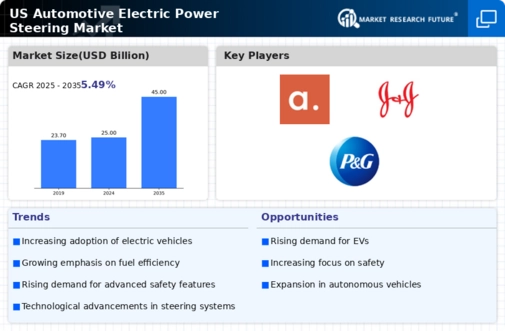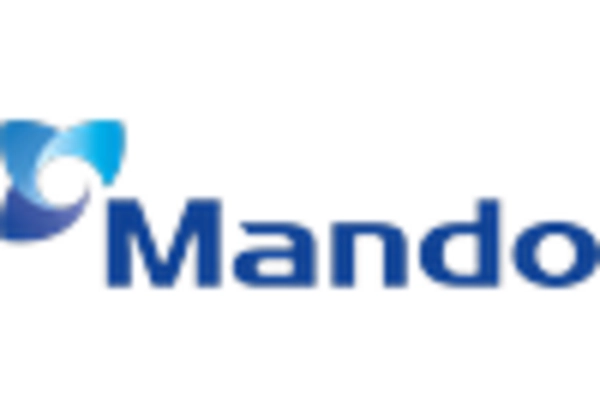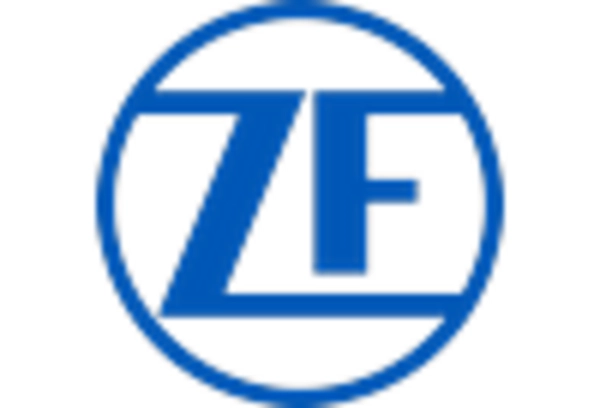Growing Electric Vehicle Adoption
The automotive electric power steering market is poised for growth due to the increasing adoption of electric vehicles (EVs). As consumers become more environmentally conscious, the demand for EVs is rising, leading to a corresponding need for compatible steering systems. Electric power steering is particularly well-suited for EVs, as it aligns with their energy-efficient design and contributes to overall vehicle performance. Recent statistics indicate that EV sales in the US have surged, with projections suggesting that they could account for over 30% of total vehicle sales by 2030. This trend is likely to drive the automotive electric-power-steering market as manufacturers seek to equip their electric models with advanced steering technologies.
Increased Focus on Vehicle Safety
The automotive electric power steering market is benefiting from an increased focus on vehicle safety. As safety regulations become more stringent, manufacturers are compelled to incorporate advanced steering technologies that enhance vehicle stability and control. Electric power steering systems offer improved responsiveness and precision, which are critical for accident prevention. In the US, the National Highway Traffic Safety Administration (NHTSA) has been advocating for enhanced safety features in vehicles, which has led to a rise in the adoption of electric power steering systems. This shift is reflected in the market, where the demand for safety-compliant vehicles is expected to grow, thereby positively impacting the automotive electric-power-steering market.
Integration of Smart Technologies
The automotive electric-power-steering market is increasingly influenced by the integration of smart technologies into vehicles. As the automotive industry embraces connectivity and smart features, electric power steering systems are evolving to incorporate advanced functionalities such as adaptive steering and personalized driving experiences. These innovations enhance driver comfort and vehicle handling, making them attractive to consumers. In the US, the demand for smart vehicles is on the rise, with a significant portion of consumers expressing interest in features that improve driving convenience. This trend suggests that the automotive electric-power-steering market will continue to expand as manufacturers innovate and integrate smart technologies into their steering systems.
Rising Demand for Fuel Efficiency
The automotive electric power steering market is experiencing a notable surge in demand driven by the increasing consumer preference for fuel-efficient vehicles. As fuel prices remain volatile, consumers are gravitating towards technologies that enhance fuel economy. Electric power steering systems contribute to this by reducing the overall weight of vehicles and improving energy efficiency. According to recent data, vehicles equipped with electric power steering can achieve fuel savings of up to 10%. This trend is particularly pronounced in the US, where regulatory standards are becoming more stringent, pushing manufacturers to adopt electric steering systems to meet efficiency targets. Consequently, the automotive electric-power-steering market is likely to expand as automakers respond to consumer demands for greener alternatives.
Advancements in Autonomous Driving Technologies
The automotive electric-power-steering market is significantly influenced by advancements in autonomous driving technologies. As the automotive industry shifts towards automation, electric power steering systems are becoming essential components for enabling precise vehicle control. These systems facilitate the integration of advanced driver-assistance systems (ADAS), which are crucial for the development of self-driving vehicles. The US market is witnessing substantial investments in research and development aimed at enhancing these technologies. It is estimated that the market for ADAS will grow at a CAGR of over 20% in the coming years, further propelling the demand for electric power steering systems. This trend indicates a robust future for the automotive electric-power-steering market as it aligns with the broader movement towards automation.

















Leave a Comment